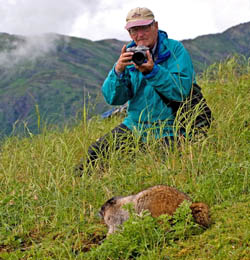
Pond succession is something you hear discussed a fair amount as pond bottoms become more rich with plant material and ultimately turn into forests – but it all happens better with beavers of course. Apparently Ducks unlimited is teaming up with USFS and Fish and Game to look at how it all plays out. Because studying something nine million times always produces different results, right?
Pacific Northwest – More Information
Background information on DU’s Pacific Northwest conservation priority area
Importance to waterbirds
These systems have traditionally been used as spring staging areas. Cook Inlet and the Copper River Delta are among the most important wetlands to the world’s populations of western sandpiper and dunlin. The Stikine is also a traditional fall staging area for Wrangel Island snow geese. Common wintering shorebirds include black oystercatchers, rock sandpipers, black turnstones, and surfbirds. Seabirds (murres, murrelets, auklets) are common breeders throughout Prince William Sound. Southeastern Alaska has over 2,800 important anadromous fish streams, and over 15,000 bald eagles use this habitat.
Goals
Complete successional vegetation modeling for the Copper River Delta and analyze pond succession related to beaver activity.
Now we both know that there are a lot of places where Ducks Unlimited does a lot of good in the world. Buying up habitat for duck hunters is useful in populated areas or areas that have been degraded by industry. But buying hunting grounds in Alaska is probably not high on the list of good deeds for the environment. And you can tell they’re clutching at any research straws hoping to justify it their presence – installing pit tags on salmon and measuring where molting is most likely to occur in geese.
But looking at the role beavers play in pond succession is soooo soooo reinventing the wheel the Alaska Parks department even has a unit on it for 4th graders. Hear that? Nine year olds know more than DU. Because it’s old news, baby.
4-6, Unit Four, Activity 5<br>”Beaver Succession Mural”
Students will discuss the concept of succession and describe beaver pond succession as one example of the process of change in natural environments. They will apply an understanding of the concept of succession by drawing a mural showing stages of beaver pond succession.
Grades: 4 – 6
Time: 1 – 2 hours
Life science, visual arts
When beavers dam a stream, they set in motion a form of succession. The resulting backwater floods lowland near the creek. Trees are soon killed, creating an opening in the forest canopy. Water-associated plants and shrubs quickly invade the pond and shoreline, creating favorable habitat for waterfowl, moose, blackbirds, amphibians, fish, insects, muskrats, wading birds, warblers, marsh hawks, and a score of other animals. After many years the water becomes shallow, filling in with silt and plant debris.
Stimulated by the nutrient-rich mud, grasses, sedges, and shrubs begin to choke the water with their accumulating debris. The ground begins to firm as more silt is trapped.
As years pass, the trees near the lodge are cut down by the beavers for use as food and shelter. The beavers must move on and find a new spot to support themselves. Without the beavers to keep it strong, the old dam collapses, draining the pond. The area becomes meadow, supporting grasses, sedges, and other flowering plants. Trees begin to re-invade the drier ground and eventually the meadow reverts to forest. Centuries may be required to see this process completed.
What can we expect next for the exciting research teams at Ducks Unlimited? One can only speculate they’ll be looking into what bears do in the woods and why ducks float instead of sink on water. The curious scientific community will have to be patient.
 In the meanwhile we can respect the work that really teaches us about beavers habitat, mostly coming out of NOAA fisheries. This morning there is another lecture on beavers and salmon offered by the Alaska Public Radio station. KTNA. I promise if you listen to the easy three minutes you’ll soon know more than any duck hunter.
In the meanwhile we can respect the work that really teaches us about beavers habitat, mostly coming out of NOAA fisheries. This morning there is another lecture on beavers and salmon offered by the Alaska Public Radio station. KTNA. I promise if you listen to the easy three minutes you’ll soon know more than any duck hunter.













































